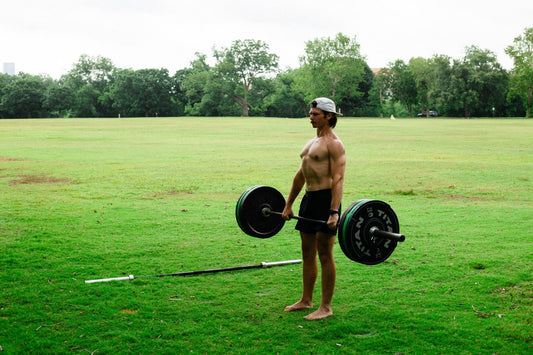Date Goes Here
The Key to Optimal Flexibility and Movement
Date Published

Background
What is mobility and why should I practice?
We should practice mobility for 15-20 minutes every day, regardless of current fitness level and exercise habits.
The one exception is if suffering from a past or present injury, practice full-body mobility to the exclusion of the injured area.
From the moment we are born we are thrust into a world that tells us to stop moving, sit still, and pay attention.
Use It or Lose It
On average, adults lose 1-2% of their muscle mass due to a process called "sarcopenia" - a natural occurrence in which the body breaks down muscle fiber due to lack of movement and composition is decreased.
This is a major contributor to the loss of mobility associated with aging. In a study conducted on over 4500 individuals aged 60 or above showed an increase in the rate of sarcopenia, doubling from 1-2% to 3-5% per year.
This study concluded that an increase in fat mass combined with a decrease in muscle mass is a leading cause of the loss of mobility.
If our life goal is to live a long, happy, healthy life, our mobility should be our number one concern, both in terms of increasing what we have, and regaining what we have lost.
The more we move, the longer we live.
Many of life's truths come in small, intuitive packages such as this: the more we move, the longer we live. Let's say that again - and this time let it sink in. The more we move, the longer we live.
In America, the majority of us don't need to crawl around on the floor, lift heavy objects, or traverse long distances in a day. But the reality is that we are meant to do all of these things, and yet, as we've just learned, what we don't use we will lose, and lose faster as we age.
But simply because we aren't required to do the kinds of work we once did doesn't mean we shouldn't be finding ways to do them regardless of circumstance. At the end of the day, maintaining our mobility is the secret weapon to combating declining health and improving our daily lives.
Practice mobility in the warm-up.
If exercising every day, congratulate yourself, as this is already a massive achievement. The next step is then to enhance the benefits of each training session by adding a series of mobility movement to our warm up routine.
When selecting mobility exercises, choose ones which aid or mimic the upcoming movements of the session. Just like a warm-up, this will help to both prime the muscles, and reduce any likelihood of injury from the following activities.
Pro Tip
If possible, include 1-3 quadrupedal mobility movements to your practice each day of the week, regardless of training focus. By spending time on our hands, feet, and knees, we build incredibly functional core strength, increase ground mobility, and improve balance.
Mobility Exercises:
Bear Crawl
This is a type of mobility called locomotion and is one of many quadrupedal movements we referenced earlier. It will increase core strength (on all planes of motion) as well as prime the body for any cardio. Start with smaller, slower movements before building to bigger, faster ones.
Crab Reach
The starting position looks like the opposite of bear crawl, however this mobility exercise does not involve locomotion. Instead it is a fantastic upper body mobility exercise which increases thoracic spinal mobility and helps decompress the core.
Side-Plank Rotation
To anyone who has completed a Yudae workout, this exercise should be very familiar. We love to include this into our warm up for every single training day regardless of training focus as it works the rotational core muscles, as well as horizontal balance.
How mobility can improve your life.
For the past 4 thousand years the human body has remained anatomically identical. A knee capsule from our ancestors is still a knee capsule now. A shoulder girdle then is still a shoulder girdle now.
In fact, many of the Western medicines we have today originated as Eastern medicines, of which their origins stem from an understanding that we (meaning you and I) are as connected to nature as we are each other.
Yet, of the 7.8 billion people in the world, 2.6 billion currently struggle with obesity as defined by a BMI of 25 points or higher. Additionally, 25% of countries in the world maintain populations of people who are classifiably obese.
History has shown us that when we pay attention to the health of our minds, our bodies, and the world as a whole, we tend to experience a better version of all three. Both internally and externally, as well as for ourselves and for each other.
Mobility exercises may just be one of the few things that can make the world a better place, and all we have to do is do it. It starts with just one foot in front of the other, and then maybe try to put a hand in there somewhere between.
TL:DR
Blog posts
View all-

The Benefits of Training Barefoot
Discover how training outdoors and grounding with the Earth can reduce stress, boost recovery, and elevate performance naturally and effectively.
The Benefits of Training Barefoot
Discover how training outdoors and grounding with the Earth can reduce stress, boost recovery, and elevate performance naturally and effectively.
-

Innovations in Fitness Tools & Technologies
Opening Anecdote I was about a year into kettlebell training when I started noticing something in the gym: notebooks and apps everywhere—people either scribbling down workouts or scrolling through plans...
Innovations in Fitness Tools & Technologies
Opening Anecdote I was about a year into kettlebell training when I started noticing something in the gym: notebooks and...
-

The 6 Most Common Running Injuries and How to P...
Running is one of the most accessible and effective forms of exercise, but it comes with risks—especially if proper precautions aren’t taken. Overuse injuries plague runners of all experience levels,...
The 6 Most Common Running Injuries and How to P...
Running is one of the most accessible and effective forms of exercise, but it comes with risks—especially if proper precautions...




